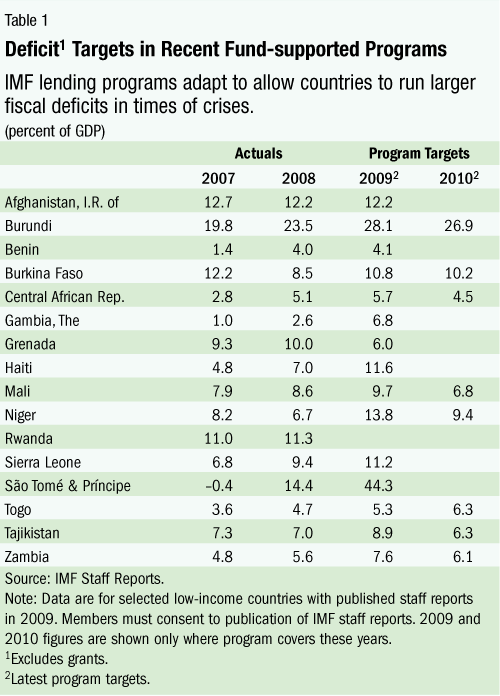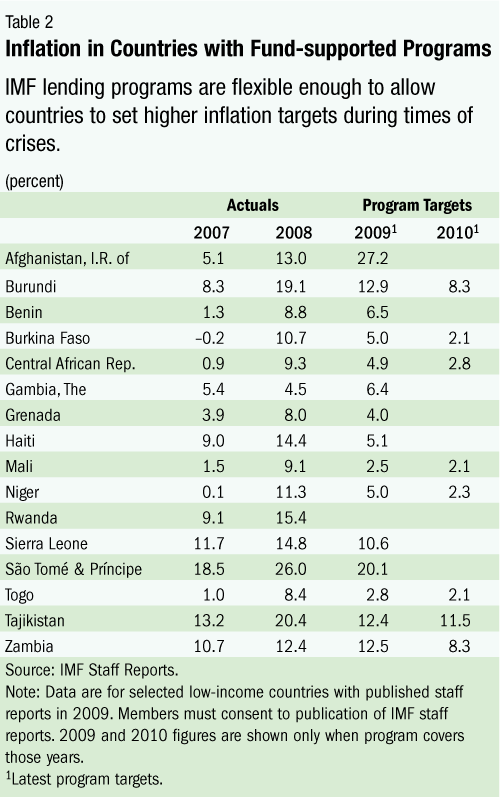
Typical street scene in Santa Ana, El Salvador. (Photo: iStock)
IMF Survey: Concern over IMF Impact on Health Spending
December 11, 2009

IMF Managing Director Dominique Strauss-Kahn meets with doctors and patients in a disability hospital in Tanzania. Mr. Strauss-Kahn visited the hospital in March 2009 (IMF photo)
Health and Social Policy
Dear IMF Survey online,
Glenn Gottselig’s interview with Sanjeev Gupta and Catherine Pattillo missed an opportunity to explore the deeper criticisms that health activists actually have about the impacts of IMF policies on health spending.
The concern is not necessarily that the IMF has a direct impact on health spending (although it can), but that, in fact, it often has several crucial but indirect impacts, many of which are longer-term in nature. A fundamental problem is that the IMF is not a development organization per se, but acts to ensure sovereign debt payments are made on time to external lenders and that creditworthiness is maintained. Thus, its short-term priority for borrowers to generate increased exports and earn foreign exchange which may be used to repay creditors.
By looking to the IMF for its assessment of the adequacy or “soundness” of a recipient country’s macroeconomic policies before giving out foreign aid each year, bilateral and multilateral aid donors have wrongly afforded tremendous leverage and power to the IMF. If the IMF was designed to prioritize development goals, that would be a different matter. But because it is not, this is of grave concern to many involved with development generally, and health outcomes specifically.
The more fundamental criticism of the IMF is its underlying ideological disposition that prioritizes short-term financial sector variables in macroeconomic policy to the subordination or neglect of real sector variables, such as long-term developmental goals, industrialization, higher employment or increased public investment. Such a position is associated with the school of monetarism within neoclassical economics and has gained ascendancy since the 1980s to become widely unquestioned in mainstream economics. Yet, while many developing countries have safely established "macroeconomic stability" for their financial variables under decades of IMF loan programs, many have also languished under a long-term trend of low-growth, low-employment and low-public investment that has been characterized by chronically insufficient health budgets and dilapidated health infrastructure.
Specifically at issue are two controversial IMF policies to keep inflation at or below 5–7 percent per year and to keep budget deficits below 3 percent of GDP.
The concern over such policies is that their degree of restrictiveness unnecessarily undermines the ability of domestic industries, to generate higher levels of productive capacity, employment, and GDP output—and thus, tax revenues—than otherwise could be the case under more expansionary fiscal and monetary policy options, thus depriving governments of higher levels of tax revenue for both recurrent expenditures, and crucially, for long-term public investment as a percent of GDP.
This is because the policy often used to lower inflation is to raise interest rates, which makes credit less affordable to both government and domestic companies; it prevents the government from engaging in more affordable deficit financing or public investment and prevents the domestic private sector from expanding production and employment—both of which carry long-term consequences for national budgets and health financing. This is why health advocates are concerned with IMF policies.
This concern had also been well articulated by a 2001 U.S. Government Accountability Office report on IMF loans, which explained: “Policies that are overly concerned with macroeconomic stability may turn out to be too austere, lowering economic growth from its optimal level and impeding progress on poverty reduction.”
It is important for readers to know that the IMF has little empirical evidence in the economics literature to justify pushing inflation down to the 5–7 per cent level, with the consequences of lower growth, lower employment, lower taxes, and lower spending that result. While everyone agrees that high inflation is bad and must be brought down, the more relevant questions are how low must inflation be brought down and at what level must it be maintained. A number of major studies have examined this question and have tried to find the “kink” in the inflation-growth relationship, or at what level inflation begins to hurt a country’s long-term GDP growth rates.
The studies show that not only are the estimates all over the place and further research is still needed, but, as Pollin and Zhu’s study notes, “There is no justification for inflation-targeting policies as they are currently being practiced throughout the middle- and low-income countries.” The same literature was reviewed by the 2007 Center for Global Development study (ironically cited by Gupta), which actually found, “Empirical evidence does not justify pushing inflation to these levels in low-income countries” and by the House Financial Services Committee of the U.S. Congress. In a November 14, 2007 Letter to the Managing Director of the IMF, the House Financial Services Committee of the U.S. Congress wrote, “We are concerned by the IMF’s adherence to overly-rigid macroeconomic targets” and “[i]t is particularly troubling to us that the IMF’s policy positions do not reflect any consensus view among economists on appropriate inflation targets.”
The 2008 Spence Commission on Growth and Development report also pointed to this specific concern in its report, saying “Very high inflation is clearly damaging to investment and growth. Bringing inflation down is also very costly in terms of lost output and employment. But how high is very high? Some countries have grown for long periods with persistent inflation of 15–30 percent.” Commission member Montek Singh Ahluwalia noted, “The international financial institutions, the IMF in particular, have tended to see public investment as a short-term stabilization issue, and failed to grasp its long-term growth consequences. If low-income countries are stuck in a low-level equilibrium, then putting constraints on their infrastructure spending may ensure they never take off.”
Despite the IMF’s recent accommodation of higher deficits and inflation during the crises of 2008 and 2009, concerns remain that in many cases these targets are programmed to be ratcheted back down to low, pre-crisis levels within one or two years out.
The key point to bear in mind is that, while the IMF and monetarists within neoclassical theory believe strongly that inflation must be driven so low, there are actually very real consequences and very important trade-offs being made behind closed doors when the finance ministries regularly agree to such low inflation targets—and high interest rates—in their loan agreements with the IMF. Economists refer to the trade-off as the “sacrifice ratio”— or the amount of GDP output that is forgone or sacrificed in order to get inflation rates down to lower levels.
Health advocates are deeply concerned about what exactly is being “sacrificed” when these targets are agreed: the lower growth and less employment means fewer taxes are collected, less public expenditure is available and public investments are foregone. This carries huge long-term social costs, and yet the costs of this approach, and the possibility of other policy options, are not subject to public debate, analysis or consideration by any wider groups of stakeholders in developing countries.
Regarding fiscal policy, the 2007 study by Center for Global Development found that, “[t]he evidence suggests that IMF-supported fiscal programs have often been too conservative or risk-averse. In particular, the IMF has not done enough to explore more expansionary, but still feasible, options for higher public spending.” Health advocates are demanding that the possible costs and benefits of such more expansionary but still reasonable options for higher public spending be fully explored in a more transparent and inclusive process that involves a broader group of stakeholders including line ministries, key legislative committees, labor, civil society and the domestic media to ensure that a broader array of policy options are fully considered with the long term public welfare as the guiding priority—and before the finance minister signs on. Such alternative options include policies to target higher employment and public investment, enhance domestic productive capacities, mobilize more domestic resources, and with a rights-based perspective. But the IMF is not yet open to such alternatives, so hence the sustained criticism.
As long as the IMF continues to promote empirically unjustifiable tight fiscal and monetary targets in nontransparent meetings with central bank and finance officials behind closed doors, then health advocates can be counted on to continue criticizing the IMF for undermining domestic capacities for health financing.
Sincerely,
Rick Rowden
Author, The Deadly Ideas of Neoliberalism: How the IMF Undermines Public Health and the Fight Against AIDS, Zed Books, London, 2009.
* * * * * * * * * * * * * * * * * * * * * * * * * * * * * * * * * * *
IMF RESPONSE
Mr. Rowden has challenged a number of statements made by us in the interview with Glenn Gottselig in the IMF Survey online. We believe that Mr. Rowden’s statements are neither supported by data nor by independent evaluations, including the most recent one by the U.S. Government Accountability Office (GAO) released on November 12, 2009.
The IMF has identified three principal criticisms that require a response:
1. IMF policies keep budget deficit targets below 3 percent of GDP.
Mr. Rowden claims that IMF-supported programs uniformly seek to tighten fiscal positions, such that these deficit targets are so tight that they do not allow sufficient space for priority spending programs. Such arguments have been repeatedly refuted by independent analysis. The Independent Evaluation Office of the IMF’s 2003 report on Fiscal Adjustments in IMF-Supported Programs concluded that “the evidence does not support the view that IMF-supported programs adopt a one-size-fits-all approach to fiscal adjustment.” Similarly, its 2007 report on IMF and Aid to Sub-Saharan Africa found that there was no evidence that IMF-supported programs were overly tight. The 2009 GAO report on IMF lending programs also notes that budget deficit targets have been applied flexibly in cases such as Liberia, where the target was increased to accommodate higher investment spending financed by concessional loans.
As indicated in Table 1, fiscal targets in recent IMF-supported programs vary widely and depend on country circumstances, such as availability of fiscal space (including external financing) and medium-term debt sustainability. As noted in the interview, most programs have accommodated larger deficits during the food and fuel crisis, as well as the most recent global financial crisis. These targets have also been designed to preserve or increase social spending—an overwhelming majority of programs have budgeted higher social spending for 2009. The Table further illustrates that fiscal deficit targets will continue to vary substantially across countries in 2010 and in most cases be higher than the pre-crisis 2007 levels, even though the crisis impact is expected to subside.

2. The IMF has very little empirical evidence...to justify pushing inflation down to the 5–7 percent level.
Mr. Rowden’s argument that IMF-supported programs seek to push inflation at or below 5–7 percent range is inaccurate.
Let’s first note that program design has been responsive to the inflation outlook as the global environment has changed. For example, as the impact of the rising global food and fuel prices intensified in the first half of 2008, programs were adapted to accommodate much higher inflation targets, as shown in Table 2.

It is incorrect to say that these increases were ignored in program design. Targets reflect macroeconomic conditions and development objectives prevailing at the time they are set. They are continuously reviewed and adjusted as economic conditions evolve over time. Thus, as global commodity prices began to fall in the second half of 2008, inflation targets were adjusted downwards in 2009 in almost all cases. For 2010, inflation targets remain higher than the pre-crisis 2007 outturn for most countries, including those that are monetary union members.
Furthermore, Mr. Rowden’s criticism that inflation targets in IMF-supported programs lack empirical foundation is misleading. According to the 2009 GAO report, “for low-income countries, empirical evidence generally suggests inflation is detrimental to economic growth after it exceeds a critical threshold of approximately 5 to 12 percent. This threshold is broadly consistent with the inflation targets of 5 to 10 percent in the 31 IMF-supported programs we reviewed.” It is therefore incorrect to suggest that inflation targets in IMF-supported program have entailed “a cost to economic growth.”
3. The IMF’s economic policies for borrowing countries are primarily designed for achieving short term priorities. ...Whether or not such short-term priorities conflict with longer-term successful economic development strategies or health goals is not the mandated concern of the IMF.
This statement is also false. Fund-supported programs are framed in the context of a medium-term macroeconomic framework that incorporates longer-term development objectives. In the case of low-income countries, programs supported under the Poverty Reduction and Growth Facility are anchored in country-owned Poverty Reduction Strategies. Short-term program targets are then developed against this framework and are frequently reviewed and adjusted, based on country specific circumstances and developments. Therefore, it is incorrect to contend that IMF policies ignore long-term development concerns. Indeed, this is recognized by the GAO report when it states, “Programs in low-income countries are broadly geared toward increasing economic growth and reducing poverty.”
The objective of IMF-supported programs is to promote high and sustained growth, which will improve the well-being of the poor and create fiscal space for increasing priority spending, including on health.
Sanjeev Gupta, Deputy Director, Fiscal Affairs Department
Catherine Pattillo, Advisor and Chief, Low-income Country Strategy Unit, Strategy, Policy and Review Department
* * * * * * * * * * * * * * * * * * * * * * * * * * * * * * * * * * *
Dear Editor:
Sanjeev Gupta and Catherine Patillo inaccurately portray my concerns with fiscal deficit reduction targets as not allowing sufficient space for "priority spending programs" whereas the concern is actually about foregone long-term public investment as a percent of GDP, which they do not address.
As evidence for the IMF's deficit-reduction targets not being unduly restrictive they cite the 2003 evaluation by the IEO, "Fiscal Adjustments in IMF-Supported Programs," yet the sampling used in this study only looked from 1993-2001, well after deficit targets had already been dramatically lowered under the original IMF stabilization loans of the 1980s. Comparing already-lowered deficit targets with continued low deficit targets to conclude that the IMF does not greatly reduce deficit spending does not seem as useful as would have a broader study going back to 1980.
As further evidence of IMF policies not being too restrictive, they cite a 2007 study by the IEO, "The IMF and Aid to Sub-Saharan Africa," yet this study did not seek to examine this question properly nor examine the relevant body of peer reviewed literature at issue, but instead merely surveyed IMF staff on their thoughts: "Meanwhile, IMF policy staff acknowledge that the empirical literature on the inflation- growth relationship is inconclusive, but weighing benefits and costs of inflation argue for an inflation target range of 5 percent to 10 percent," which, "is consistent with IMF Board policy of single-digit inflation" (p.10).
Gupta and Patillo also cite the very recent 2009 GAO study that does purport to examine the relevant studies in the economics literature on the question of determining the danger point for the kink in the inflation/growth relationship (the point at which inflation begins to hurt future GDP growth rates). Unfortunately, the GAO report used a highly dubious methodology which deserves greater scrutiny. The full bibliography lists 16 studies in the economics literature which were examined, but then, astonishingly, the authors eliminated 7 of these studies, including major seminal works by Fischer, Easterly and Bruno (many of which found higher estimated thresholds), because they were from prior to 1999 and the GAO report authors claimed "the cost of inflation was understated because researchers failed to acknowledge the complex, or nonlinear, nature of the relationship between inflation and economic growth." Then the authors eliminated a further 3 studies (two with higher thresholds) because they were "outliers" when plotted on the graph, thus leaving just 6 of the original 16 studies examined from which to draw conclusions. In a stunning display of ingenuity, the GAO report finally deduced the safe threshold range for inflation to be between 5 to 12 percent, or nearly consistent with the IMF policy of using inflation targets in the 5 to 10 percent range. While interesting, one wonders if this methodology would pass through a peer-review in any of the major economics journals.
Finally, Gupta and Patillo do not address a central concern—the fall in public investment as a percent of GDP, and how and under what conditions it may ever be increased so countries can develop. They do not address such concerns as raised by the 2001 GAO report, the Pollin and Zhu study, the 2007 Center for Global Development study, the letter to IMF from the U.S. House Financial Services Committee or by the 2008 Spence Commission on Growth and Development report.
Sincerely,
Rick Rowden


